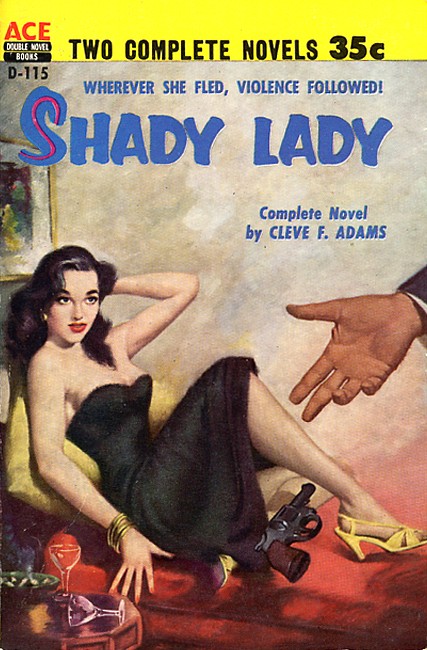| Vintage Pulp | Aug 30 2023 |

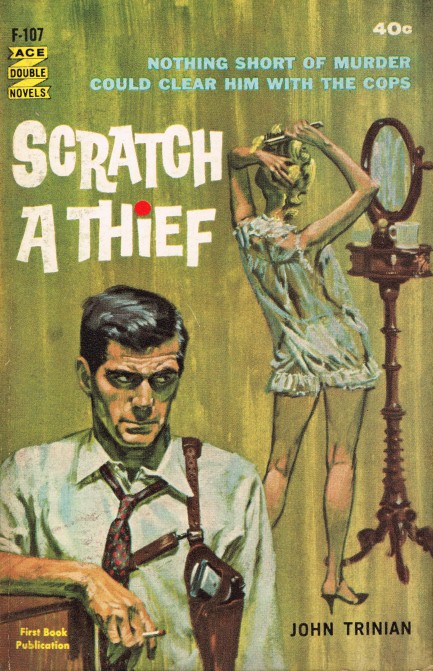
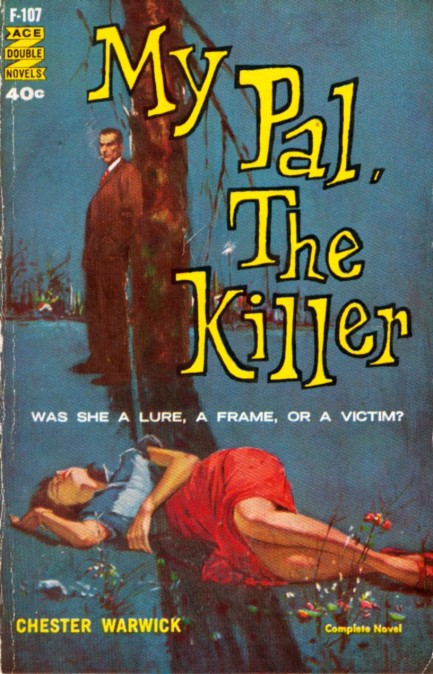
The thieving business runs hot and cold, and it reaches freezing depths when your girlfriend starts giving you a hard time about your earnings. Actually, let's not restrict that to thieving. It's true whatever your chosen field happens to be. John Trinian's Scratch a Thief was published in 1961 as an Ace Double Novel with Chester Warwick's My Pal, The Killer. Scratch a Thief later became a movie with Alain Delon and Ann-Margret in the leads, and at that time was retitled Once a Thief and credited to Trinian's pseudonym Zekail Marko. In reality, he was neither Trinian nor Marko, but Marvin Schmoker. So, you can understand the name changes. High school must have been hell for the guy. We haven't read him yet but we'll get around to it. And maybe to Chester Warwick too. You never know. But we'll for sure get around to the movie.
| Vintage Pulp | May 11 2023 |

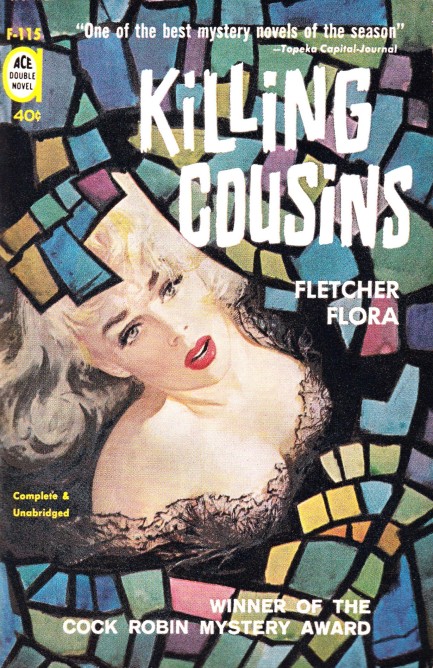
For a few years we've been meaning to get back to Fletcher Flora, and finally we've done it. Above you see his half of an Ace Double novel—Killing Cousins. The book is about a spoiled suburban wife who shoots her husband, then calls on one of her lovers—her husband's cousin—for help in covering up the crime. Cousin Quincy is known to be a genius, and he relishes the challenge of outwitting the cops. Generally, he does fine. It's the people around him he can't count on, including his cousin Fred, who, because he doesn't know about the murders and thus doesn't realize the importance of what he's asked to do, botches his crucial task. It's only the first of many problems.
Flora has a unique voice, no doubt about it. Some might find it too self-conscious, but we liked it. Check out the two examples below:
By comparison, John Crieghton's, aka Joseph L. Chadwick's, The Blonde Cried Murder is much more what you'd expect from a mid-century crime novel. The set-up sounds like the beginning of a joke: a woman walks into a detective's office. We like books that start that way. We think
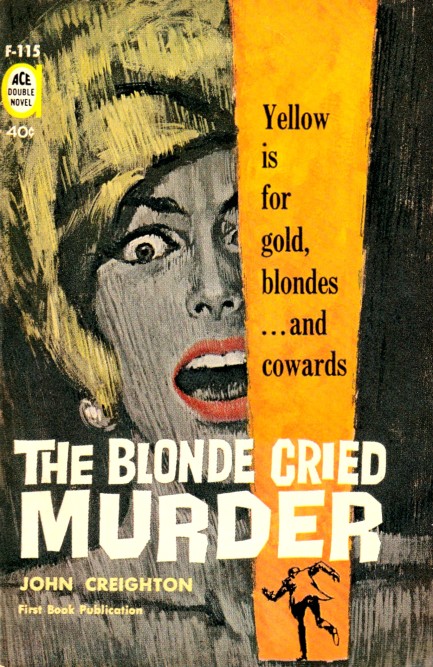 of such authors the way we think of musicians who decide to cover a classic. It's been done before, but not in that exact style. So, a woman walks into downtrodden private dick Ed Donovan's office and asks him to find a missing person—her husband, who may have fled to avoid the police.
of such authors the way we think of musicians who decide to cover a classic. It's been done before, but not in that exact style. So, a woman walks into downtrodden private dick Ed Donovan's office and asks him to find a missing person—her husband, who may have fled to avoid the police.| Vintage Pulp | Nov 12 2020 |

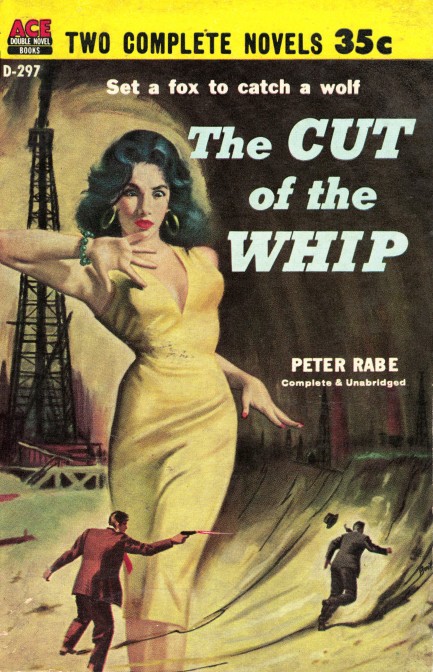
We're back into quasi-quarantine where we live, so what better way to use up double the idle time than with an Ace double novel? In The Cut of the Whip a loner named Dan Port fetches up in a dusty Texas oil town and finds bad luck and trouble when his sports car is rammed and totaled. The person who did it was fleeing town with a sheaf of valuable business documents. The owner of those dox—the fugitive's father—pays Port to retrieve them, and soon he finds himself the only person who can foil a kidnapping plot. The previous books we've read by Rabe verged on bizarre in terms of concept, but this outing is more conventional—we suppose because Port was a franchise character. Rabe would eventually wheel him out for six adventures. We missed the Rabe of efforts like The Box and Kill the Boss Good-by, but he's adequate here, if less imaginative. Port blows into town, whips the asses that need whipping, and drifts away to who-know's-where. Just like a franchise character should.
Robert H. Kelston's Kill One, Kill Two, like its partner book, starts with a deadly auto incident. Maybe that's why the novels were paired. But similarities vanish from that point forward. This book is set in Monterrey, Mexico, and opens with a bang when the protagonist runs over a man on a dark highway. Kelston uses this event to frame a set of circular relationships: there's the protagonist Allen McCoy, who is bedding Juanita, a local nude dancer widely considered to be the most beautiful woman in Monterrey, who is watched over by her hot-headed brother, and is lusted after by a knife fighter known as the Shadow, who's acquaintances with an alcoholic blonde temptress of easy virtue, who is having an affair with the dancer's husband, but all along is trying to bed studly Mr. McCoy.
We've given nothing away with that summary. Kelston shoehorns all that into the first thirty or so pages, and you might have to re-read them to keep the connections straight. Who was it that got run over, you're wondering? That would be Juanita's husband Raúl, the guy who's making naughty spoons with the blonde. Thus McCoy is perceived to have gotten a romantic rival out of the way, and is believed by local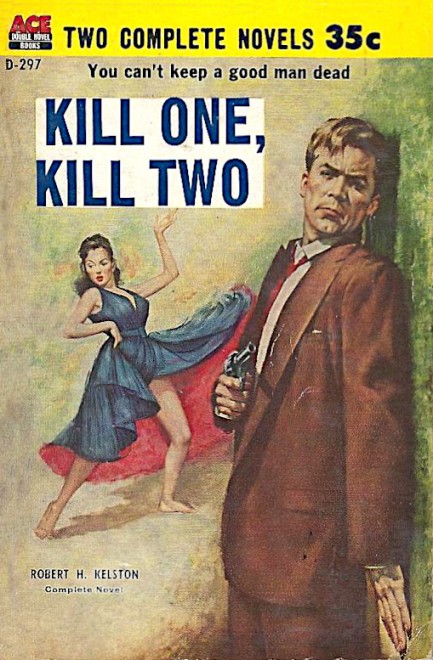 gossips to now be bedding both the dancer and the blonde. In local macho culture that makes him a pure stud, but for his corporate employers it makes him radioactive. The gossips have it all wrong, though. The death was an accident, a result of drunken driving and darkness. McCoy soon comes to believe that poor Raúl was thrown in front of his car, and must solve the mystery or see his career destroyed by the rumors.
gossips to now be bedding both the dancer and the blonde. In local macho culture that makes him a pure stud, but for his corporate employers it makes him radioactive. The gossips have it all wrong, though. The death was an accident, a result of drunken driving and darkness. McCoy soon comes to believe that poor Raúl was thrown in front of his car, and must solve the mystery or see his career destroyed by the rumors.
That's all fine, but the entire story turns out to be a fish too big for Kelston to land. He has it on the hook, then sees it wriggle off through pointless dialogue, confused motivations, and general lack of clear direction. We accepted the main character's motivation, but not necessarily his flimsy engineering background, nor his extraordinary bravery and physical competence in the face of danger. After all, he's just a builder. But that's genre fiction for you—on the page anyone can be a stud, even a pasty-ass, red-headed numbers cruncher like Allen McCoy. A cruel editor would have improved this tale, but in the end we enjoyed it anyway, because owing to our background we're predisposed to like adventures set in Latin America. The fact that it came packaged as an Ace double helped. We have a few other Ace doubles in the website, and you can see the whole lot by clicking its keywords below.
| Vintage Pulp | Apr 15 2020 |

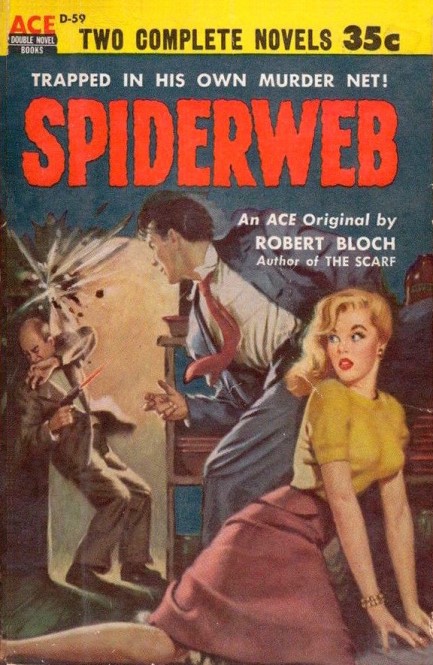
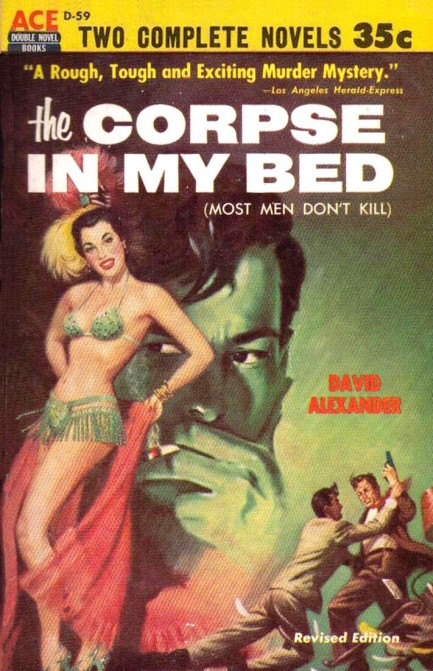 The Corpse in My Bed, originally titled Most Men Don't Kill, tells the story of a former soldier who in his civilian career as a detective finds himself in the classic shamus pickle—standing over a corpse amidst possibly incriminating evidence. A war related head wound plus some booze leaves him unsure whether he merely found the body or caused it, so he goes into hiding while his partner Chet and an acquaintance nicknamed Tommy Twotoes try to get to the bottom of the puzzle. It isn't easy to come up with a character that really stands out in the pantheon of mid-century crime fiction. Twotoes—a 300-pound millionaire with a weird affinity for penguins—is one you'll remember for a while. We checked to see if Alexander used him in other novels, but as far as we can tell he didn't, though he seemingly showed up in a few short stories. Both Bloch and Alexander do good work here, a bit rough around the edges at times, but well worth a read. Just don't pay $350, like one vendor is charging. We got them for twenty bucks. Schwing!
The Corpse in My Bed, originally titled Most Men Don't Kill, tells the story of a former soldier who in his civilian career as a detective finds himself in the classic shamus pickle—standing over a corpse amidst possibly incriminating evidence. A war related head wound plus some booze leaves him unsure whether he merely found the body or caused it, so he goes into hiding while his partner Chet and an acquaintance nicknamed Tommy Twotoes try to get to the bottom of the puzzle. It isn't easy to come up with a character that really stands out in the pantheon of mid-century crime fiction. Twotoes—a 300-pound millionaire with a weird affinity for penguins—is one you'll remember for a while. We checked to see if Alexander used him in other novels, but as far as we can tell he didn't, though he seemingly showed up in a few short stories. Both Bloch and Alexander do good work here, a bit rough around the edges at times, but well worth a read. Just don't pay $350, like one vendor is charging. We got them for twenty bucks. Schwing! 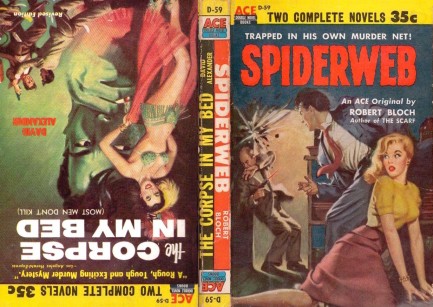
| Vintage Pulp | Feb 13 2019 |

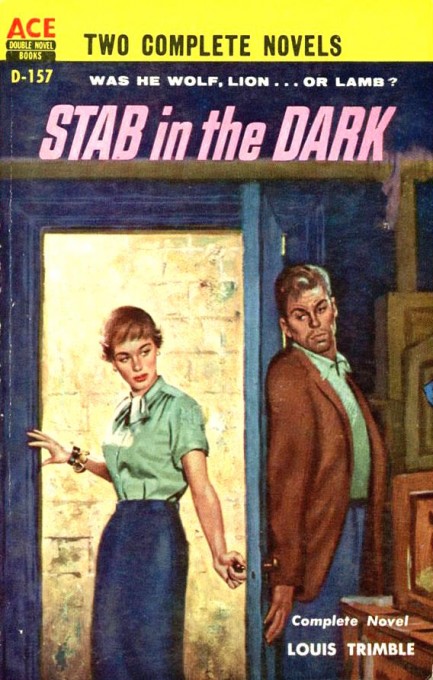
Louis Trimble's Stab in the Dark is one half of an Ace double novel, the other half of which—Jonathan Gant's Never Say No to a Killer—we powered through in one day back during the fall of 2017. Ordinarily when you finish one of these doubles you start right in on the back side, but you know how easily distracted we are. We finally got around to Stab, though, and it pits a secret agent against a group of blackmailers in possession of dirty photos of important people. Sounds fun, doesn't it? But there's nothing special here. We assume Trimble did better work elsewhere. 1956 on this, with unattributed cover art.
| Vintage Pulp | Dec 6 2017 |

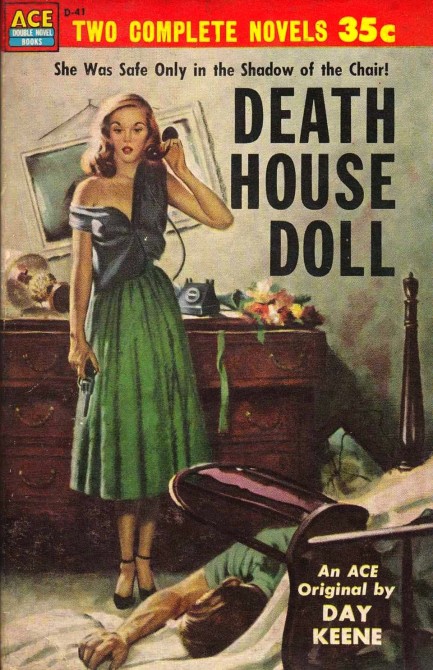
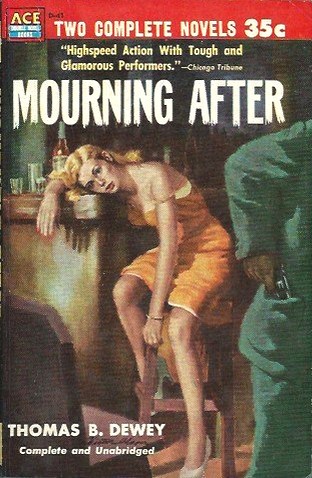 Above, a nice cover for Day Keene's 1954 thriller Death House Doll, with excellent art credited to Bernard Barton, who's aka Harry Barton (Bernard was his middle name). In the story, a Korean War vet has promised his fatally wounded brother he'd look after his wife and baby daughter, but when he gets back to the world (Chicago) he's stunned to find that she's sitting on death row for murder, and unwilling to spill the truth even if it saves her. The attraction with this one is watching a decorated war hero run riot on hoods and thieves, while up against the always effective ticking clock gimmick—an execution date, which in this case is five days hence. The book was an Ace Double with Thomas B. Dewey's Mourning After on the flipside, and the art on that one, just above, is by Victor Olson. We put together a nice collection of Harry Barton's work back in May that we recommend you visit at this link.
Above, a nice cover for Day Keene's 1954 thriller Death House Doll, with excellent art credited to Bernard Barton, who's aka Harry Barton (Bernard was his middle name). In the story, a Korean War vet has promised his fatally wounded brother he'd look after his wife and baby daughter, but when he gets back to the world (Chicago) he's stunned to find that she's sitting on death row for murder, and unwilling to spill the truth even if it saves her. The attraction with this one is watching a decorated war hero run riot on hoods and thieves, while up against the always effective ticking clock gimmick—an execution date, which in this case is five days hence. The book was an Ace Double with Thomas B. Dewey's Mourning After on the flipside, and the art on that one, just above, is by Victor Olson. We put together a nice collection of Harry Barton's work back in May that we recommend you visit at this link.
| Vintage Pulp | Nov 10 2017 |

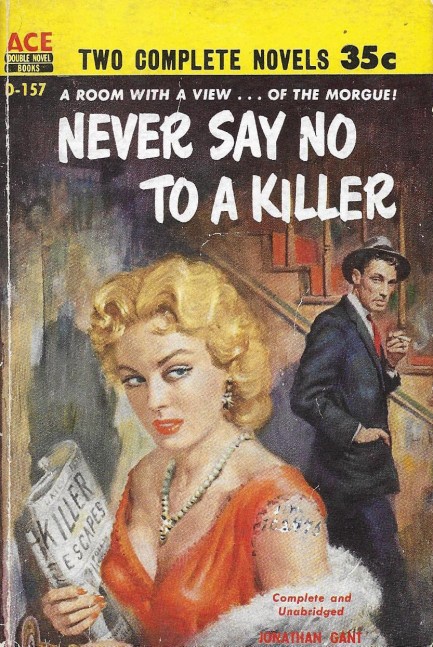
Since the story is told from first person point-of-view you have no evidence he's a blowhard, but for a guy who's allegedly so much smarter than everyone else plenty of things go wrong with his schemes, and the corpses he generates don't inspire confidence in his self assessment. And indeed, later you discover definitively that he isn't bright at all—he just has an enormous ego, one that allows him to bluster his way through problems, but which keeps him from spotting obvious dangers and prevents him from understanding it's he who's being played.
He believes beautiful women are his reward for being so much better than everyone else, which makes it especially satisfying when these women begin giving him trouble. If he were really a genius he'd have known that you never cross a femme fatale. Never Say No to a Killer is not an especially well written book, but the story is great and the lead character of Roy Surratt is rare. Well, rare in fiction. In real life people like him are everywhere. Overall this is decent-but-not-great stuff from Ace Double Novels, circa 1956, with uncredited cover art, and Louis Trimble's Stab in the Dark on the flipside.
| Vintage Pulp | Aug 4 2017 |

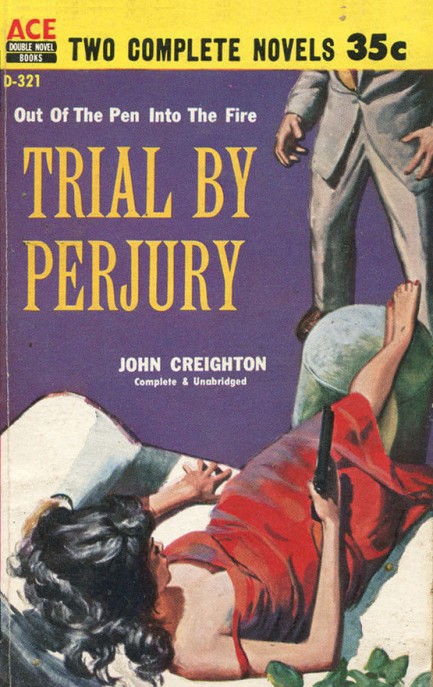
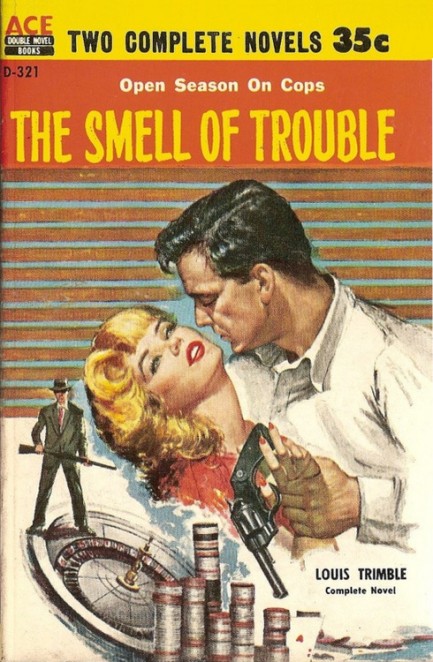
Above, an Ace double consisting of John Creighton's Trial by Perjury and Louis Trimble's The Smell of Trouble. Cover art is by uncredited and his twin brother unattributed. You can see another Ace double here.
| Vintage Pulp | Feb 4 2017 |

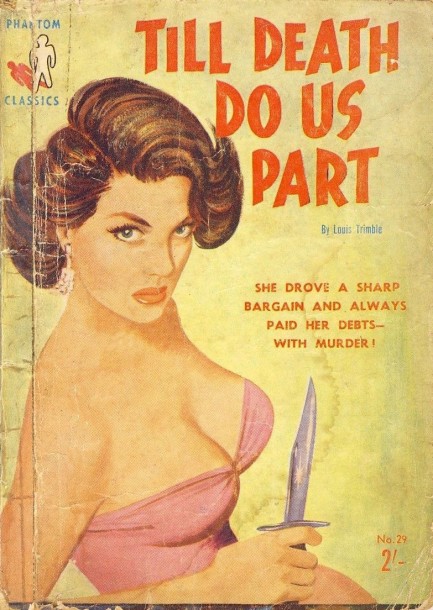
A gringo detective with an agency in Mexico City is hired to locate his crooked ex-partner, who has bailed with the agency's money, and now is causing trouble for the client. The PI takes the job, glad to be paid to track down his betrayer, and starts in the Mexican town of Rio Bravo where the partner immediately turns up dead. From there the hero delves into local corruption, crosses the border to Texas, uncovers a human trafficking ring, meets a cantina dancer named Arden Kennett, deals with a dangerous wife, watches murders pile up and the police begin to suspect him, and learns that knives can be thrown just as effectively as they can be brandished.
The book was published in the U.S. as an Ace Double in 1959 with Paul Rader art and bound with Charles Fritch's Negative of a Nude, but the rare edition above is from Aussie imprint Phantom Books and appeared in 1960. We can't identify the artist, which is an affliction we've been dealing with quite a bit of late. But don't blame us—as we've mentioned once or twice before, including just a few days ago, Phantom didn't credit art, possibly because much of it was copied from U.S. editions. Many of the covers do, however, look like the same hand, so hopefully someone will be able to ID the owner of that hand at some point in the future.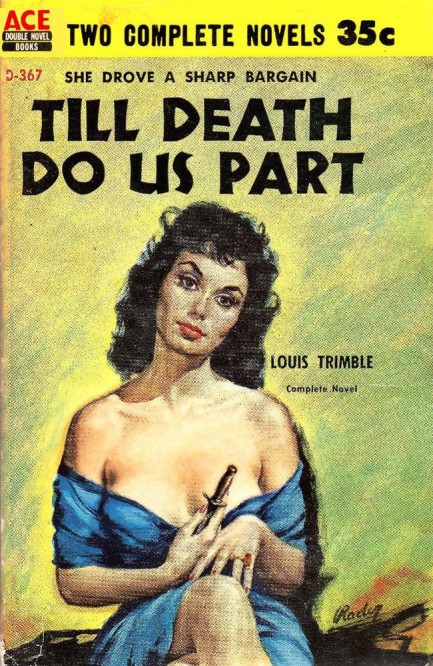
| Vintage Pulp | Dec 12 2016 |

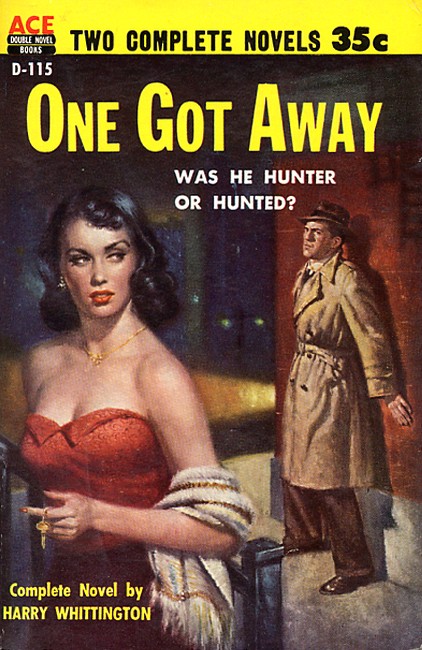
Well, some products don't work as advertised. We weren't going to buy it, but then we learned it came with a complimentary limited edition newspaper with two eye holes cut in it. But when we wore the coat we got spotted immediately and now we have a restraining order. 1955 copyright on this Ace Double of Harry Whittington's One Got Away (Robert Schulz cover art), bound with Cleve F. Adams' Shady Lady (Harry Barton on the art chores). We'll see you after our probation hearing.